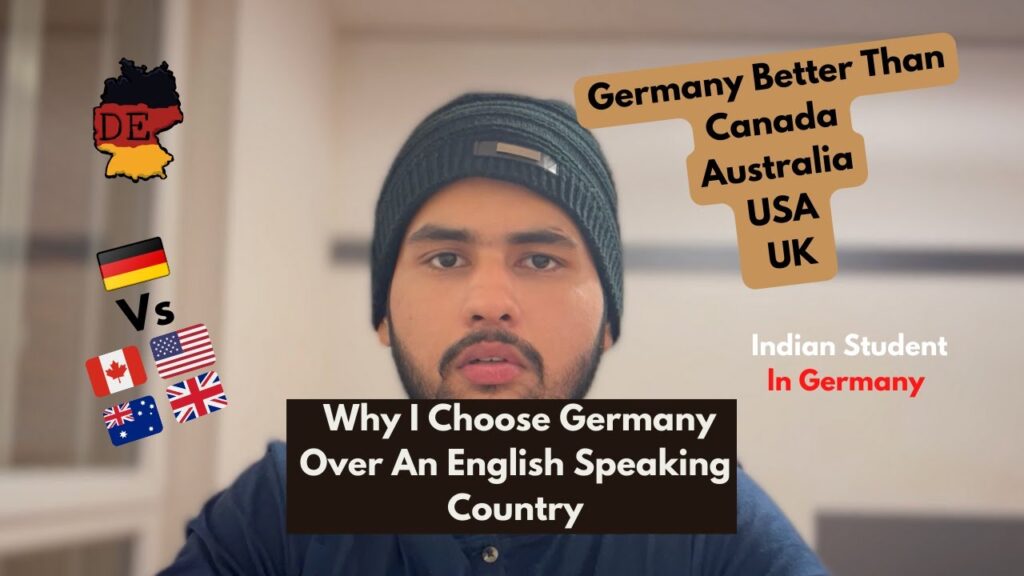Here is a detailed tabular comparison of US universities, Canadian universities, and German universities for international students from India:
| Category | United States | Canada | Germany |
| Tuition Fees | High | Moderate | Low |
| Cost of Living | High | Moderate | Moderate |
| Scholarships | Available | Available | Limited |
| Work Opportunities | Available | Limited | Limited |
| Language of Instruction | English | English/French | German |
| International Rankings | High | High | High |
| Program Diversity | High | Moderate | High |
| Student Diversity | High | Moderate | Moderate |
| Application Process | Complex | Straightforward | Straightforward |
| Visa Process | Complex | Straightforward | Straightforward |
| Job Opportunities | High | Moderate | High |
| Post-Graduation Stay | Complex | Straightforward | Straightforward |
| Student Support | Available | Available | Available |
Tuition Fees:
US universities have the highest tuition fees among the three countries, while Canada has moderate tuition fees, and Germany has low tuition fees.
Cost of Living:
The cost of living in the US is high, while it is moderate in Canada and Germany.
Scholarships:
All three countries offer scholarships to international students, but the availability of scholarships is limited in Germany.
Work Opportunities:
The US has the most work opportunities for international students, followed by Germany and Canada.
Language of Instruction:
The language of instruction in the US and Canada is primarily English, while in Canada, it can also be French. In Germany, the language of instruction is primarily German.
International Rankings:
All three countries have high international rankings for their universities.
Program Diversity:
The US and Germany have high program diversity, while Canada has moderate program diversity.
Student Diversity:
The US has the most diverse student population, followed by Canada and Germany, which both have moderate student diversity.
Application Process:
The application process for US universities is complex, while it is straightforward in Canada and Germany.
Visa Process:
The visa process for the US is complex, while it is straightforward in Canada and Germany.
Job Opportunities:
The US and Germany have high job opportunities for international students, while Canada has moderate job opportunities.
Post-Graduation Stay:
The post-graduation stay process in the US is complex, while it is straightforward in Canada and Germany.
Student Support:
All three countries offer student support to international students.
Post Education Settlement Prospects in USA, Canada and Germany
International students who have completed their studies in the United States have several options for staying in the country. The most common way is to apply for Optional Practical Training (OPT), which allows students to work in their field of study for up to 12 months after graduation. STEM students can apply for an additional 24 months of OPT, bringing their total time in the United States to 36 months.
After completing their OPT, international students can also apply for an H-1B visa, which allows them to work in the United States for up to six years. This visa is typically issued to workers in specialty occupations, and the student must have a job offer from a U.S. employer to apply.
Career prospects:
The United States is home to many world-class universities and a thriving economy, making it an attractive destination for international students looking to launch their careers. Graduates with degrees in STEM fields, particularly computer science and engineering, are in high demand and can expect to find many job opportunities. Business and healthcare are also growing fields that offer many job opportunities.
Canada:
Post-study settlement immigration prospects:
International students in Canada can apply for a Post-Graduation Work Permit (PGWP), which allows them to work in Canada for up to three years after graduation. To be eligible for the PGWP, the student must have completed a program of study that was at least eight months long at a designated learning institution in Canada.
After working in Canada for a certain amount of time, international students can also apply for permanent residency through several immigration programs, including the Express Entry system, the Provincial Nominee Program, and the Quebec Experience Program.
Career prospects:
Canada is known for its high quality of life and welcoming attitude towards immigrants, making it a popular destination for international students. Graduates with degrees in STEM fields, particularly computer science and engineering, are in high demand and can expect to find many job opportunities. Healthcare, business, and environmental science are also growing fields that offer many job opportunities.
Germany:
Post-study settlement immigration prospects:
International students in Germany can apply for an 18-month residence permit after graduation to look for work in Germany. If they find a job that is in line with their qualifications, they can apply for a work visa. After working in Germany for a certain amount of time, international students can also apply for permanent residency.
Career prospects:
Germany is known for its strong economy and highly skilled workforce, making it an attractive destination for international students looking to launch their careers. Graduates with degrees in engineering, computer science, and natural sciences are in high demand and can expect to find many job opportunities. Healthcare and business are also growing fields that offer many job opportunities.
Overall, the United States, Canada, and Germany offer many opportunities for international students to launch their careers and establish themselves in their chosen fields. However, the specifics of post-study settlement immigration prospects and career prospects can vary depending on individual circumstances and the current job market. It is important for students to research their options and make informed decisions about their career paths.

